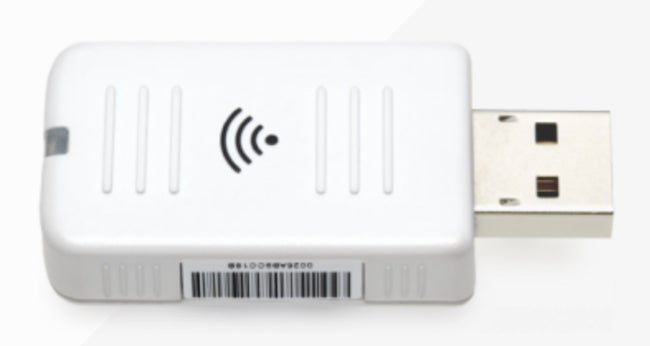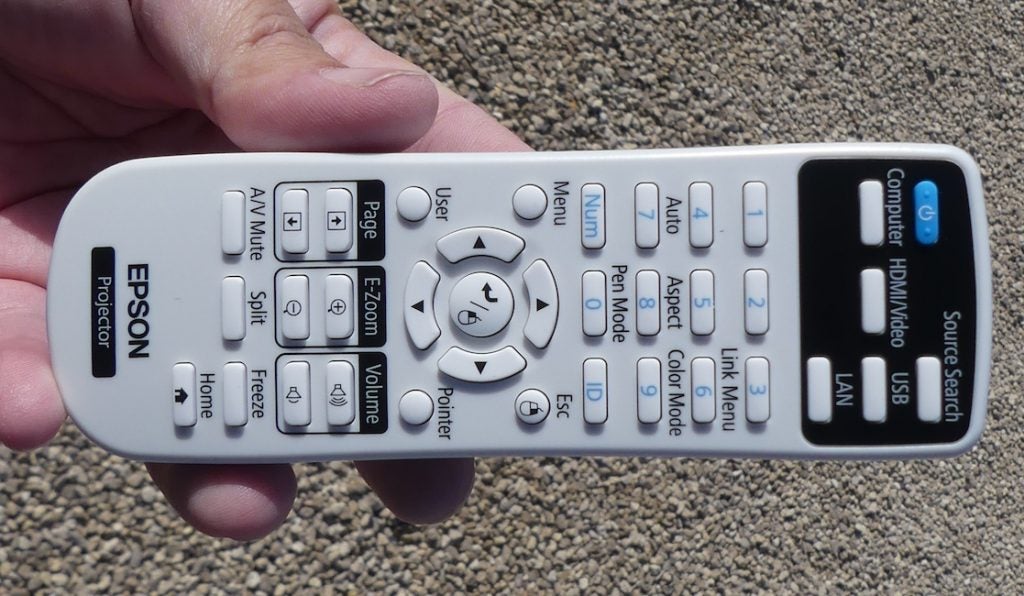Epson EH-LS100 Review
Epson EH-LS100
A surprisingly affordable and effective alternative to a mega-screen TV
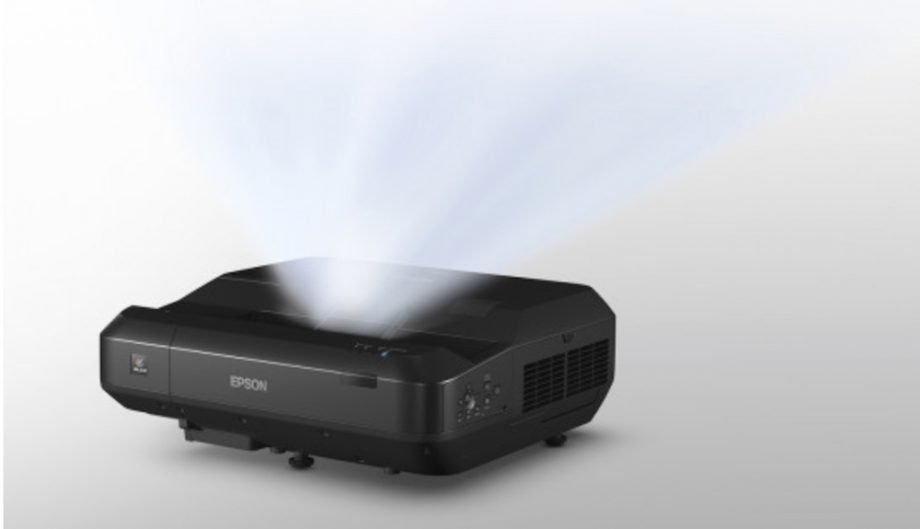
Verdict
Pros
- Remarkably bright pictures remain watchable in ambient light
- Very affordable for a laser projector
- Convenient ultra short-throw design
Cons
- Black levels are below par for dark-room viewing
- Runs noisily in its brightest modes
- Hard to avoid using keystone correction
Key Specifications
- Review Price: £2600
- Ultra short-throw design gives 70-130-inch image from 41-78cm throw distance
- Laser lighting system
- 10 years' lifespan at five hours use a day
- 4000 lumens brightness
- Face detection safety system
What is the Epson EH-LS100?
The Epson EH-LS100 is the first ultra short-throw projector we’ve seen to use a laser light source. Even better, it’s also the first to deliver the advantages of laser lighting for just £2600. All of which could just make it a genuine, eye-catchingly affordable replacement for a really (really) big TV.
The only pity is that it doesn’t quite have what it takes to be a serious home cinema projector, too.
Related: Best projectors
Epson EH-LS100 – Design and build quality
The Epson EH-LS100 is pretty big and bulky by typical home projector standards. It’s also rather poorly built, weighing much less than it looks. In short, it’s pretty much just a chunky lump of dark grey plastic.
Before your inner interior design guru gets too upset, however, the LS100 has a cool room-friendly trick up its sleeve. Namely that its ultra short-throw design means you can put it just inches from your wall or screen. On a sideboard, say, or a dedicated shelf.
There’s no need to try to accommodate the projector in the middle of your room, or on your ceiling. So, despite its chunkiness, it’s actually less of an imposition on your decor than any normal projector would be.
Even better, it’s much less of an aesthetic imposition than a king-sized TV. After all, unlike a huge TV it can deliver an image up to 130 inches across without leaving a gaping black hole in your wall when you’re not watching it.
Sadly, the projector’s remote control is a horror show. Its small face is horribly crowded with tiny, rather randomly laid out buttons. These also don’t carry any backlighting, making them all but unusable in a dark room.
However, regarding this last point, I guess Epson could fairly argue that the EH-LS100 isn’t really designed for dark room use. It’s positioned more as a potential living room TV replacement than a typical home cinema projector.
Epson EH-LS100 – Features
The EH-LS100’s use of a laser light system delivers some key advantages. For starters, unlike normal lamp projectors, you can turn off the LS100 immediately. There’s no need for it to cool down before pulling the plug.
Laser light sources also enjoy a vastly longer lifespan than the bulbs found in typical lamp projectors. In fact, Epson claims the LS100 can last a decade, based on five hours a day of use in its Eco mode.
It should be said that the Epson EH-LS100’s ‘TV replacement’ ambitions mean you might end up using it more than a normal projector. But even so, that laser-based lifespan is very impressive.
The other big thing about the laser light source is its brightness. Epson reckons the LS100 can pump out a colossal 4000 lumens – potentially enough to make it genuinely watchable in ambient light.
The LS100 also claims a contrast ratio of 2,500,000:1 – although as we’ll see, ultimately, this figure looks rather optimistic.
One issue with laser lighting is that its intense brightness can damage your eyes if you look straight into the lens. To stop this happening, the LS100 features a sensor near its lens that turns the laser off if it detects anything – such as a child’s face – coming close to the light output window.
The ultra short-throw design of the LS100 sees its images being bounced around inside the projector so that they can emerge through a window that faces up and backwards towards your wall or screen. This can deliver an image of 70-130 inches, with the ‘lens’ just 41-78 centimetres from your wall/screen.
The Epson EH-LS100 can’t handle 4K or HDR; it’s Full HD, standard dynamic range only. This is marginally disappointing, but really only to be expected with such a ground-breakingly affordable laser model. Also, its HD resolution is likely perfectly adequate for the relatively casual user scenarios the LS100 is designed to satisfy.
There’s no support for 3D, either. But, in this respect, the LS100 is in line with the vast majority of its rivals these days.
One interesting quirk of the LS100’s resolution is that it’s actually 1920 x 1200, not the usual Full HD 1920 x 1080. This 16:10 pixel setup suggests some PC rather than video heritage in the LS100’s optical make-up – even though it has two Cinema modes and one Game mode among its picture presets.
The LS100 is unusually well connected. Particularly great to see are three HDMIs rather than the usual two. One of these supports MHL, too.
Plus there’s a composite video input, two audio inputs, an audio output, VGA ports for connecting monitors and computers, three USBs (two Type-A, and one Type-B) and some handy system integration options. Namely an RS232 control port, an Ethernet port, and even a slot for adding Wi-Fi.
With all that in mind, it isn’t too surprising to find the LS100 supporting PJLink and Crestron RoomView control systems.
Epson EH-LS100 – Setup
There are good points and bad points about the Epson EH-LS100’s physical set-up features.
On the upside, you can just pop it on a shelf or table under your screen – and that’s it. There’s no need to clear a space in the middle of your room, or move your seats away from the projector’s noise/heat zone.
Having the projector so close to your walls also makes it easier to connect source equipment without running lengthy cables everywhere. What’s more, this also means the sound from its built-in speaker actually seems to come from the picture. This is a very pleasant change from the detached audio effect you get with typical projector sound systems.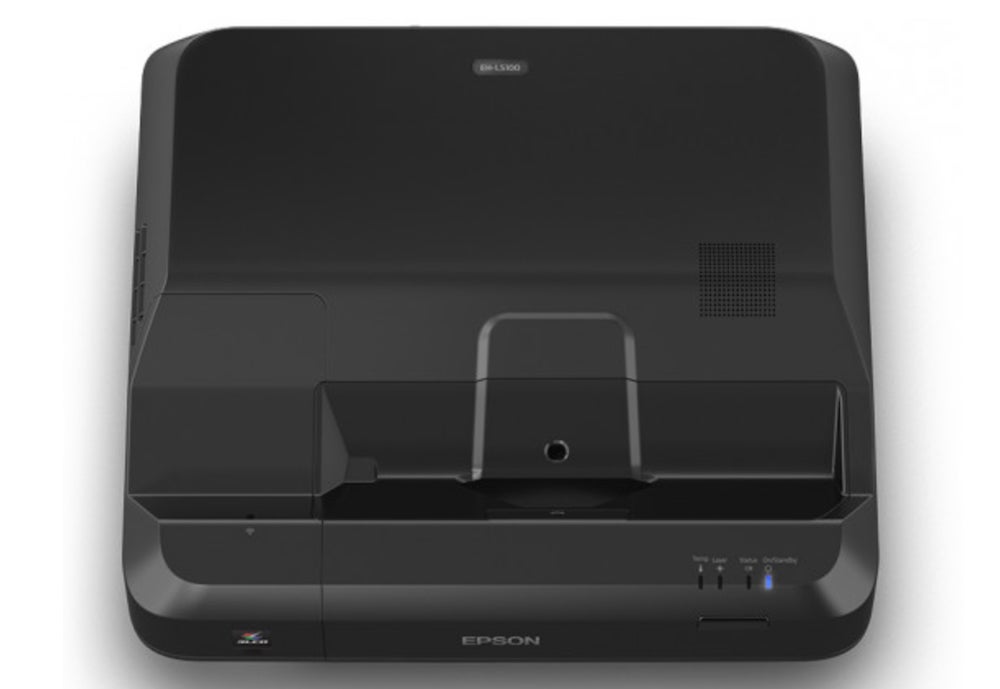
On the downside, the ultra short-throw design means there’s no optical zoom. You can only change the image size by moving the projector forward or backwards. There’s no vertical image shifting, either.
Adjusting the height of the image thus depends on three screws that sit down legs on the projector’s underside. Since using these legs means you’re changing the angle at which the picture is hitting your wall, you’ll have to use keystone correction to make the edges of the picture perpendicular. This isn’t ideal, as keystone correction essentially removes the picture’s pixel-for-pixel precision.
You can at least adjust the image’s focus – although, oddly, the focus ‘slider’ is hidden away beneath the flap that covers the projector’s dust filters.
Note that you should concentrate on the top of the image when making your focus adjustments, since this area is much more prone to being out of focus than the bottom due to the way ultra short-throw projectors work.
The Epson EH-LS100’s menus include plenty of fine-tuning options in mostly sensibly organised menus. Four presets get the ball rolling: Dynamic, Bright Cinema, Cinema and Game. You should move between these quite fluidly to get the best from the projector with different sources and situations.
In a really bright room, Bright Cinema’s extra punch is a must. However, in a mid-bright room, I’d argue that you’d get better results with the Cinema preset and the projector’s lamp control set to Extended. This takes out some of the blue tone that creeps into the Bright Cinema preset.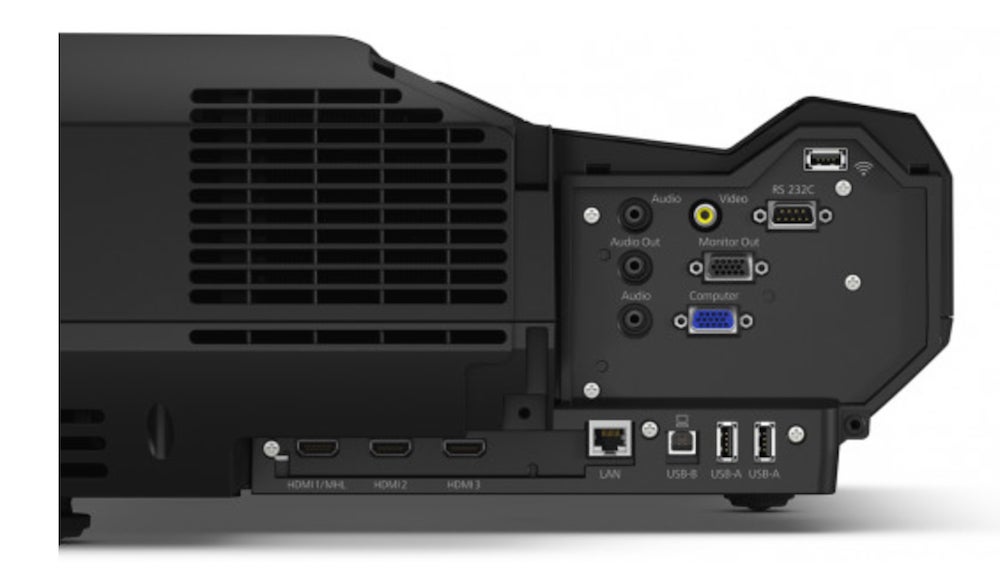
Choosing ‘Game’ is essential when you’re using the projector with a PC or console. It reduces input lag from around 100ms in the other modes to around 45ms on average.
I’d avoid the Dynamic preset, since it introduces a pretty overpowering yellowy undertone that’s hard to remove via calibration – despite the fact that there’s a decent set of white balance and colour calibration tools at your disposal.
Epson has provided a couple of picture-processing systems in the LS100. One of these, noise reduction, I’d recommend you leave tuned off with all but the grubbiest sources.
The Detail Enhancement tool is more useful, but only up to its 20-25 setting. Go higher than that and it can make the picture look gritty.
Another key setting is Dynamic Contrast. This can be off, Normal, or High Speed. Off isn’t an option, since it destroys contrast. High Speed gives the most consistently good results, but can suffer some distractingly stark brightness ‘leaps’ during fade to blacks. If you’re watching content containing regular fades to black, or which features very dark sequences, your best bet would be to stick with Normal.
One last issue to consider with the LS100 settings is fan noise. Unless you’re using the Cinema preset and/or you have the lamp set to Quiet, the LS100 makes quite a racket. Certainly more than can be hidden by its built-in speakers.
Yet, if you don’t have the lamp set to a fairly high level, the LS100’s pictures lose a lot of punch – especially in bright room conditions.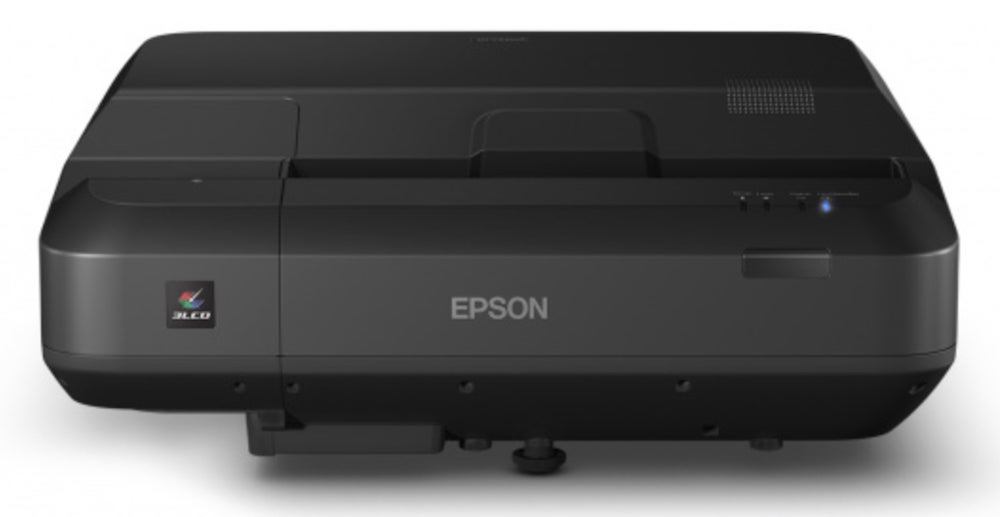
Basically, you’ll just have to try all the lamp options in your typical room light conditions and see if you find the noise with high brightness settings tolerable.
Epson EH-LS100 – Performance
The LS100 is impressive as a ‘lifestyle’ product, but less so as a true home cinema option.
The key to its lifestyle success is its brightness. That laser really does deliver fearsome amounts of light. In its Bright Cinema mode it punches easily through even quite high amounts of ambient light, to deliver a picture that often isn’t just still watchable, but genuinely impactful.
So successful is the LS100 in this regard that it even manages to pick out some quite subtle shadow details in dark areas. No remotely affordable non-laser projector I’ve seen has managed that when having to contend with any amount of ambient light.
Pumping out so much brightness also means projector retains more colour saturation in ambient light than any similarly affordable rival.
This is most obvious in the richness of the sort of bold tones on show during your average World Cup football match – an event for which the LS100 feels tailor-made.
This is also impressively apparent in the way it helps skin tones still look natural and credible. There’s far less impact from ambient light’s desaturating effects than usual.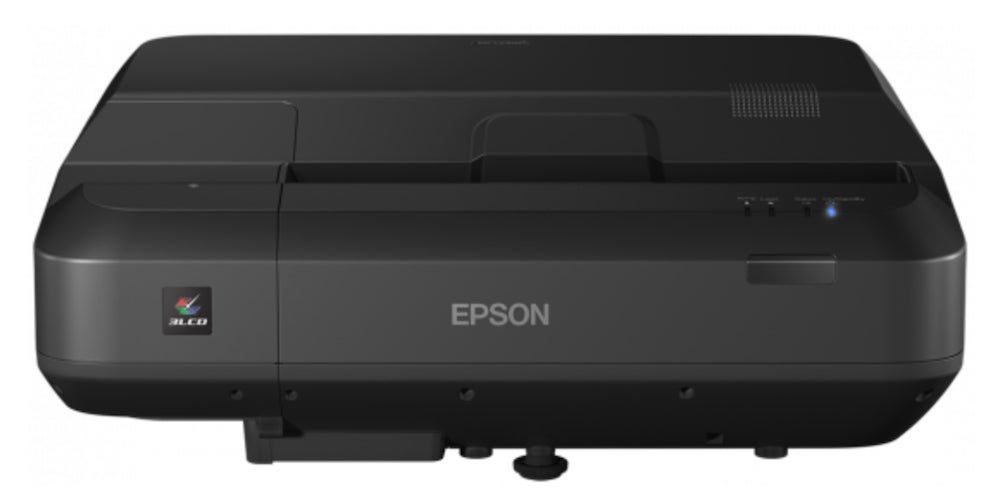
The LS100’s brightness helps it retain greater sharpness and detail in ambient light than other projectors.
Actually, the LS100 makes every pixel of its Full HD resolution count in dark and light rooms alike. It’s also great to see that the sharpness isn’t lost when there’s motion in the frame. Even without any motion processing, the LS100 keeps judder and blur impressively low.
Some of the talents I’ve just described hold good if you switch to more serious movie viewing in a dark room. The image’s overall level of ‘pop’ is even more spectacular with the lights down. Even if you use the relatively low-intensity Cinema picture preset.
It’s also pleasing with the LCD-based LS100 not to have to worry about the rainbow effect (stripes of red, green and blue) that can flit over the pictures of rival DLP projectors.
Watching in the dark does expose a pretty stark problem, however: seriously limited black levels. Dark scenes look grey where they should look black, which instantly makes them unconvincing and flat.
Ironically, having praised the LS100 for delivering more detail than usual in ambient light, it actually delivers less shadow detail than most rivals would in a dark room setup. Subtle details just don’t survive the greyness.
Colours, too, look strangely less convincing in dark room conditions than they do in bright ones. The intensity of the boldest tones looks forced, and skin tones are peaky. Some of this can be improved via the picture adjustments, but my feeling is that the LS100 has been tuned for use in ambient light – and there’s only so much you can do to counteract that.
Also evident in dark rooms is minor exaggeration of source noise when using the Bright Cinema or Dynamic presets.
The sound from the LS100’s built-in speaker is effective in some ways. Particularly handy is the way it seems to cast its sound upwards. Couple this with the projector’s physical closeness to your wall, and the sound actually seems to be coming from the pictures it’s accompanying. This is practically unheard of with a built-in projector sound system.
Unfortunately, while the LS100 can go quite loud, it can also sound quite harsh. This is true both with high-pitched treble sounds and dense action scenes or bits of score. Especially if violins are involved… Ouch.
Why buy the Epson EH-LS100?
The LS100 is a truly unique projector. Its ultra short-throw design and exceptional laser-driven brightness make it a brilliant way of watching big sporting events at a larger-than-life size without having to black your room out.
It’s a pretty fun option for gaming, too, and I guess it could just about serve as a full-time TV replacement – provided that you’re mostly into watching bright, colourful daytime TV or sports events.
What the LS100 is not, however, is a true home cinema projector. It just doesn’t have the contrast and black level performance to convince with Blu-ray movies in a dark room. If you’re after a projector for that, you’d be better looking at the Sony VPL-HW65ES or, if you want to step up to a 4K model, the Optoma UHD60.
Verdict
The LS100 is a unique proposition. It doesn’t quite pass muster as a serious movie machine, but it could certainly make a great entertaining option for big-screen gaming or big-match sports parties – in the daytime only.
Trusted Score
Score in detail
-
Value 9
-
Features 7
-
Image Quality 7
-
Design 7
Features
| Native Aspect Ratio | 16:10 |
| Projector Type | LCD Ultra short throw |
| Brightness (Lumen) | 4000 |
| Contrast Ratio | 2,500,000:1 (!) |
| Resolution | 1920 x 1200 |
| Full HD 1080p | Yes |
| 3D Ready | No |
| Max Diagonal Image Size (Inch) | 130 |
| Min Projection Distance (Foot) | 1.35 |
| Max Projection Distance (Foot) | 2.56 |
| Lamp Type | Laser |
A/V Ports
| HDMI | 3 |
| Composite | 1 |
| Ethernet | Yes |
| WiFi | Yes (Via optional £99 adaptor) |
Physical Specifications
| Height (Millimeter) | 188 |
| Width (Millimeter) | 494 |
| Depth (Millimeter) | 437 |
| Weight (Gram) | 11000 |


